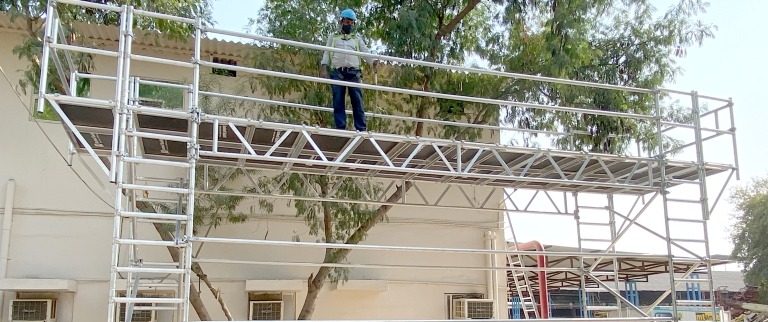November 25,2024
Which Scaffold Do I Hire? Aluminium Or Steel?
 Scaffolding is critical for safe and efficient access to elevated work areas in construction and maintenance projects. Selecting the right scaffolding material impacts the safety, cost, and productivity of your project. Here, we explore the types of scaffolding materials, compare steel and aluminium options, and examine the unique advantages of aluminium scaffolding. Discover why over 10,000 industries trust Mtandt's aluminium scaffold to meet the highest safety and performance standards.
Scaffolding is critical for safe and efficient access to elevated work areas in construction and maintenance projects. Selecting the right scaffolding material impacts the safety, cost, and productivity of your project. Here, we explore the types of scaffolding materials, compare steel and aluminium options, and examine the unique advantages of aluminium scaffolding. Discover why over 10,000 industries trust Mtandt's aluminium scaffold to meet the highest safety and performance standards.What is Scaffolding?
Scaffolding is a temporary structure that supports workers and materials during construction, maintenance, and repair activities. It allows crews to work at different heights safely and provides easy access to hard-to-reach areas, ensuring work efficiency and reducing potential risks.
Types of Scaffolding Materials
Understanding the different types of aluminium scaffolding helps you select the best option for your project:
• Mobile Aluminium Scaffolding: Equipped with braked wheels, mobile scaffolds can quickly move around job sites and are ideal for indoor and outdoor projects.
• Aluminium Scaffold Tower: Built for higher elevations, these towers consist of vertical frames, horizontal braces, and sturdy work platforms. They are commonly used in tall structures.
• Folding Aluminium Scaffold: Compact and foldable, these scaffolds are lightweight and easy to store. They are suitable for small-scale projects with limited space.
Choosing the right scaffolding material is essential to maximizing safety and efficiency. Let's examine two popular choices: aluminium scaffolding v/s steel scaffolding
| Criteria | Aluminium Scaffolding | Steel Scaffolding |
| Durability and Strength | Highly durable, withstands harsh conditions, ideal for long-term projects | Less durable in some situations, but corrosion-resistant |
| Load-bearing Capabilities | Can support substantial weight, suitable for heavy-duty projects | Lower load-bearing capacity compared to steel |
| Resistance to Wear and Tear | Resistant to damage, lasts longer in tough conditions | Corrosion-resistant but may not withstand heavy impacts |
| Weight | Heavy, making transportation, setup, and dismantling labor-intensive | Lightweight, easy to transport and maneuver |
| Rust and Corrosion Resistance | Prone to rust and corrosion if not maintained | Resistant to corrosion, ideal for outdoor and humid environments |
| Assembly and Disassembly | Complex, time-consuming, requires more labour due to weight | Quick and easy to assemble/disassemble, reducing labor time |
| Cost | More affordable upfront but may incur higher long-term maintenance costs | Can be costly initially but offers savings on labor and maintenance |
Benefits of Aluminium Scaffolding
Factors to Consider When Choosing Scaffolding Material
When selecting scaffolding, consider the specific needs of your project, including:
1. Project Duration: For long-term projects, durability is critical.
2. Environmental Conditions: Choose corrosion-resistant materials for outdoor or humid conditions.
3. Load Requirements: Heavy-duty tasks may require steel, while lighter projects can benefit from the convenience of aluminium.
4. Budget Constraints: Factor in both upfront costs and long-term maintenance.
Why Mtandt Aluminium Scaffold?
Commonly Asked Questions:
What are The Advantages of the Aluminium Scaffold System?